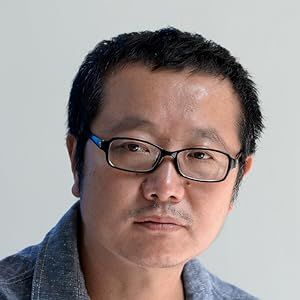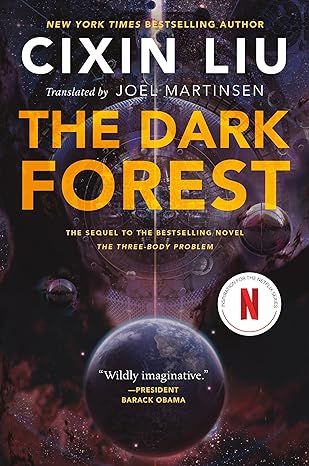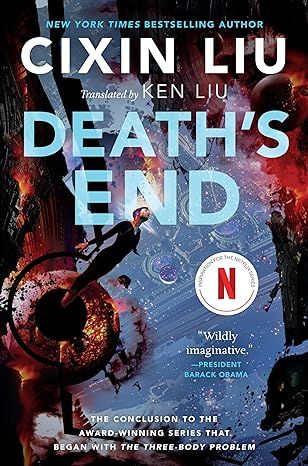The Three-Body Problem
4.4
-
46,179 ratings
The inspiration for the Netflix series 3 Body Problem!
WINNER OF THE HUGO AWARD FOR BEST NOVEL
Over 1 million copies sold in North America
“A mind-bending epic.”―The New York Times • “War of the Worlds for the 21st century.”―The Wall Street Journal • “Fascinating.”―TIME • “Extraordinary.”―The New Yorker • “Wildly imaginative.”―Barack Obama • “Provocative.”―Slate • “A breakthrough book.”―George R. R. Martin • “Impossible to put down.”―GQ • “Absolutely mind-unfolding.”―NPR • “You should be reading Liu Cixin.”―The Washington Post
The Three-Body Problem is the first novel in the groundbreaking, Hugo Award-winning series from China's most beloved science fiction author, Cixin Liu.
Set against the backdrop of China's Cultural Revolution, a secret military project sends signals into space to establish contact with aliens. An alien civilization on the brink of destruction captures the signal and plans to invade Earth. Meanwhile, on Earth, different camps start forming, planning to either welcome the superior beings and help them take over a world seen as corrupt, or to fight against the invasion. The result is a science fiction masterpiece of enormous scope and vision.
The Three-Body Problem Series
- The Three-Body Problem
- The Dark Forest
- Death's End
Other Books by Cixin Liu
- Ball Lightning
- Supernova Era
- To Hold Up the Sky
- The Wandering Earth
- A View from the Stars
Kindle
$11.99
Available instantly
Audiobook
$0.00
with membership trial
Hardcover
$19.59
Paperback
$13.17
Ships from
Amazon.com
Payment
Secure transaction
ISBN-10
9780765382030
ISBN-13
978-0765382030
Print length
416 pages
Language
English
Publisher
Tor Books
Publication date
January 11, 2016
Dimensions
6.05 x 1.05 x 9.15 inches
Item weight
15.4 ounces
Frequently bought together
Popular Highlights in this book
If this was so, then how many other acts of humankind that had seemed normal or even righteous were, in reality, evil?
Highlighted by 5,942 Kindle readers
Every era puts invisible shackles on those who have lived through it, and I can only dance in my chains.
Highlighted by 4,628 Kindle readers
But she was a woman. A woman should be like water, able to flow over and around anything.
Highlighted by 3,857 Kindle readers
Product details
ASIN :
0765382032
File size :
5054 KB
Text-to-speech :
Enabled
Screen reader :
Supported
Enhanced typesetting :
Enabled
X-Ray :
Enabled
Word wise :
Enabled
Editorial Reviews
Praise for the Three-Body Problem series:
"Wildly imaginative."―President Barack Obama
“A mind-bending epic.”―The New York Times
“Absolutely mind-unfolding. . . . a science-fiction epic of the most profound kind.”―NPR
“A breakthrough book . . . a unique blend of scientific and philosophical speculation, politics and history, conspiracy theory and cosmology.”―George R. R. Martin
"Liu Cixin's writing evokes the thrill of exploration and the beauty of scale. . . . Extraordinary."―The New Yorker
“[Liu turns] technically complex and existentially dreadful ideas into books that are impossible to put down.”―GQ
“A fascinating novel of ideas."–TIME
"The best kind of science fiction, familiar but strange all at the same time."―Kim Stanley Robinson
"Remarkable, revelatory, and not to be missed."―Kirkus Reviews, starred review
"Fans of hard SF will revel in this intricate and imaginative novel."―Publishers Weekly, starred review
“War of the Worlds for the 21st century.”―Wall Street Journal
“Liu’s picture of humanity’s place in the cosmos is among the biggest, boldest and most disturbing we’ve seen.”―Los Angeles Times
“Provocative.”―Slate
“A gripping and haunting sci-fi mystery.”―Cosmopolitan
"A must-read in any language."―Booklist
Sample
1 The Madness Years
China, 1967
The Red Union had been attacking the headquarters of the April Twenty-eighth Brigade for two days. Their red flags fluttered restlessly around the brigade building like flames yearning for firewood.
The Red Union commander was anxious, though not because of the defenders he faced. The more than two hundred Red Guards of the April Twenty-eighth Brigade were mere greenhorns compared with the veteran Red Guards of the Red Union, which was formed at the start of the Great Proletarian Cultural Revolution in early 1966. The Red Union had been tempered by the tumultuous experience of revolutionary tours around the country and seeing Chairman Mao in the great rallies in Tiananmen Square.
But the commander was afraid of the dozen or so iron stoves inside the building, filled with explosives and connected to each other by electric detonators. He couldn’t see them, but he could feel their presence like iron sensing the pull of a nearby magnet. If a defender flipped the switch, revolutionaries and counter-revolutionaries alike would all die in one giant ball of fire.
And the young Red Guards of the April Twenty-eighth Brigade were indeed capable of such madness. Compared with the weathered men and women of the first generation of Red Guards, the new rebels were a pack of wolves on hot coals, crazier than crazy.
The slender figure of a beautiful young girl emerged at the top of the building, waving the giant red banner of the April Twenty-eighth Brigade. Her appearance was greeted immediately by a cacophony of gunshots. The weapons attacking her were a diverse mix: antiques such as American carbines, Czech-style machine guns, Japanese Type-38 rifles; newer weapons such as standard-issue People’s Liberation Army rifles and submachine guns, stolen from the PLA after the publication of the “August Editorial”1; and even a few Chinese dadao swords and spears. Together, they formed a condensed version of modern history.
Numerous members of the April Twenty-eighth Brigade had engaged in similar displays before. They’d stand on top of the building, wave a flag, shout slogans through megaphones, and scatter flyers at the attackers below. Every time, the courageous man or woman had been able to retreat safely from the hailstorm of bullets and earn glory for their valor.
The new girl clearly thought she’d be just as lucky. She waved the battle banner as though brandishing her burning youth, trusting that the enemy would be burnt to ashes in the revolutionary flames, imagining that an ideal world would be born tomorrow from the ardor and zeal coursing through her blood.… She was intoxicated by her brilliant, crimson dream until a bullet pierced her chest.
Her fifteen-year-old body was so soft that the bullet hardly slowed down as it passed through it and whistled in the air behind her. The young Red Guard tumbled down along with her flag, her light form descending even more slowly than the piece of red fabric, like a little bird unwilling to leave the sky.
The Red Union warriors shouted in joy. A few rushed to the foot of the building, tore away the battle banner of the April Twenty-eighth Brigade, and seized the slender, lifeless body. They raised their trophy overhead and flaunted it for a while before tossing it toward the top of the metal gate of the compound. Most of the gate’s metal bars, capped with sharp tips, had been pulled down at the beginning of the factional civil wars to be used as spears, but two still remained. As their sharp tips caught the girl, life seemed to return momentarily to her body.
The Red Guards backed up some distance and began to use the impaled body for target practice. For her, the dense storm of bullets was now no different from a gentle rain, as she could no longer feel anything. From time to time, her vinelike arms jerked across her body softly, as though she were flicking off drops of rain.
And then half of her young head was blown away, and only a single, beautiful eye remained to stare at the blue sky of 1967. There was no pain in that gaze, only solidified devotion and yearning.
And yet, compared to some others, she was fortunate. At least she died in the throes of passionately sacrificing herself for an ideal.
Battles like this one raged across Beijing like a multitude of CPUs working in parallel, their combined output, the Cultural Revolution. A flood of madness drowned the city and seeped into every nook and cranny.
At the edge of the city, on the exercise grounds of Tsinghua University, a mass “struggle session” attended by thousands had been going on for nearly two hours. This was a public rally intended to humiliate and break down the enemies of the revolution through verbal and physical abuse until they confessed to their crimes before the crowd.
As the revolutionaries had splintered into numerous factions, opposing forces everywhere engaged in complex maneuvers and contests. Within the university, intense conflicts erupted between the Red Guards, the Cultural Revolution Working Group, the Workers’ Propaganda Team, and the Military Propaganda Team. And each faction divided into new rebel groups from time to time, each based on different backgrounds and agendas, leading to even more ruthless fighting.
But for this mass struggle session, the victims were the reactionary bourgeois academic authorities. These were the enemies of every faction, and they had no choice but to endure cruel attacks from every side.
Compared to other “Monsters and Demons,”2 reactionary academic authorities were special: During the earliest struggle sessions, they had been both arrogant and stubborn. That was also the stage in which they had died in the largest numbers. Over a period of forty days, in Beijing alone, more than seventeen hundred victims of struggle sessions were beaten to death. Many others picked an easier path to avoid the madness: Lao She, Wu Han, Jian Bozan, Fu Lei, Zhao Jiuzhang, Yi Qun, Wen Jie, Hai Mo, and other once-respected intellectuals had all chosen to end their lives.
Those who survived that initial period gradually became numb as the ruthless struggle sessions continued. The protective mental shell helped them avoid total breakdown. They often seemed to be half asleep during the sessions and would only startle awake when someone screamed in their faces to make them mechanically recite their confessions, already repeated countless times.
Then, some of them entered a third stage. The constant, unceasing struggle sessions injected vivid political images into their consciousness like mercury, until their minds, erected upon knowledge and rationality, collapsed under the assault. They began to really believe that they were guilty, to see how they had harmed the great cause of the revolution. They cried, and their repentance was far deeper and more sincere than that of those Monsters and Demons who were not intellectuals.
Read more
About the authors
Cixin Liu
Liu Cixin, born in June 1963, is a representative of the new generation of Chinese science fiction authors and recognized as a leading voice in Chinese science fiction. He was awarded the China Galaxy Science Fiction Award for eight consecutive years, from 1999 to 2006 and again in 2010. His representative work The Three-body Problem is the BEST STORY of 2015 Hugo Awards, the 3rd of 2015 Campbell Award finalists, and nominee of 2015 Nebulas Award. His works have received wide acclaim on account of their powerful atmosphere and brilliant imagination. Liu Cixin's stories successfully combine the exceedingly ephemeral with hard reality, all the while focussing on revealing the essence and aesthetics of science. He has endeavoured to create a distinctly Chinese style of science fiction. Liu Cixin is a member of the China Writers' Association and the Shanxi Writers' Association.
Read more
Reviews
Customer reviews
4.4 out of 5
46,179 global ratings
Kindle Customer
5
This is a good read. It well deserves the Hugo Award that it won.
Reviewed in the United States on May 16, 2024
Verified Purchase
This book is the first part of a four part Science Fiction series written by a well-known (in China) author of stories in this genre.
I read the book after having seen the Netflix six-part series based on the book. The book was much clearer on the science of the three body problem (apparently a well known problem in physics), a situation in which a planet is in a solar system that has three suns. The length of days and years is highly variable and unpredictable in this configuration, which strongly influences the development of civilization on the planet.
The book made the psychology and motivations of the characters much clearer than the Netflix series did, as well as the relationship between the characters, and the meaning of a computer game (also called Three Body Problem) that is a major vehicle for developing the backstory of the alien civilization on the aforementioned planet.
The producers of the Netflix series took a few liberties with the story in the book. At least one character male character in the book is female in the series, and some incidents are in a different order, but on the whole the series portrays the SF aspect of the book very well.
The quality of the writing is really good. I understand why the book won a Hugo award. I plan to at least begin the second volume of the trilogy. The concept of a trilogy like this is reminiscent Of Asimov's Foundation trilogy, and even Heinlein's Future History, not only because each is a series of novels and stories, but because this book is such a good read.
Read more
3 people found this helpful
Casey Dorman
5
Mind-boggling science fiction!
Reviewed in the United States on August 31, 2021
Verified Purchase
Award winning Chinese science fiction author Cixin Liu has said, “Science fiction is a literature that belongs to all humankind. It portrays events of interest to all humanity, and thus science fiction should be the literary genre most accessible to readers of different nations.” I think this is true, or at least it can be. For science fiction to appeal to everyone on the planet it is necessary that its stories portray situations that are relevant to everyone, that they are written about in a way that doesn’t exclude those whose cultural or societal beliefs fall into one political camp or another, and, most of all, it requires a literate world in which everyone has enough of their basic needs met that they have time for leisure reading.
We are a long way from the ideal state described above, but some books are a movement toward it. Cixin Liu’s “The Three-Body Problem “represents a step in that direction. Liu lives in the People’s Republic of China. When I think of science fiction audiences, China doesn’t come immediately to mind, but that is because of my ignorance, not reality. “The Three-Body Problem” not only won the Hugo Award after its translation into English in 2014, but it also won China’s Galaxy Award for best science fiction in 2006, the year of its publication in China. Cixin Liu has won the Galaxy Award, which I didn’t even know existed, 9 times.
“The Three-Body Problem “is hard science fiction, meaning that it is literally filled with science, some of it real, much of it speculative with kernels of real science leading to wildly fantastic consequences. One of its themes is the overturning of the basic principles of modern physics, or at least the apparent overturning of them, since another theme is the deliberate undermining of belief in those principles. The underlying plot of the novel is the mutual discovery of another race in our galaxy, mutual in the sense that we discover them at the same time that they discover us.
The ideas contained in this novel are mind-boggling. What appears fanciful becomes less and less so, as more science behind it is revealed, although the science too, get stretched until everything seems fanciful, but I as a reader, was never sure if it was based on realistic science or not. That’s part of the entertaining quality of the book. The extraordinary discoveries come one after another, gradually unfolding the true plot that is determining the characters’ actions.
There are political criticisms in “The Three-Body Problem,” almost entirely of China’s Cultural Revolution of the 1960’s and 70’s. As such, they are a criticism of constraining science because of political or philosophical reasons. The author himself has made some political statements, almost entirely in favor of Chinese government policies, which have earned him enough suspicion in the U.S. that several Republican Congressmen objected when they heard that Netflix was creating a film version of his work. But modern Chinese politics are not an issue in the novel. Liu’s comments at the end of the English translation of the book make it clear that he hopes science fiction such as his can bring the world together.
A word about character development in “The Three-Body Problem.” The early portions of the book cover several years and skip from one character to another, many of them who die. Finally, the story settles down to a small set of regular characters. Some Western critics have complained that the characters are “shallow,” which may be valid when comparing the novel to many Western ones. I suspect that this reflects a difference between Western and Eastern cultures, as well as difference between science fiction as a genre (at least old-style science fiction) and other fiction genres. Our Western mindset is to attribute the causes of a person’s behavior to elements of their personality. They are adventurous, courageous, lazy, lackadaisical, psychopathic, etc. Sociological research has suggested that many Eastern cultures tend to see the causes of behavior as due to events and circumstance or even luck, rather than to ongoing personality characteristics (it is a more vs less difference, rather than an either-or difference). Liu’s novel takes the latter approach, giving a detailed description of the circumstances leading characters to do what they do in the novel. It is not a lack of depth of characters so much as it represents a different approach to character motivation that is reflective of the overall culture of the writer. In the case of “The Three-Body Problem,” this results in the novel gradually providing the basis for different characters’ otherwise puzzling behavior by providing after-the-fact stories of what happened in their lives to cause them to behave as they do.
I found this book to be absolutely intriguing and impossible to put down until I got to its end. I am eager to read the two novels that are its sequels. It is science fiction at its very best
Read more
148 people found this helpful
Sepharious
5
Incredible Hard Sci-fi
Reviewed in the United States on April 17, 2024
Verified Purchase
This book is so important for the sci-fi genre. I prefer reading sci-fi, some fantasy, and political commentary from various viewpoints.
I would say that not only this book, but the rest of the trilogy contains some very dark moments and I would call it Horror-Lite, not because of what the book says in plain language, but what is left to the imagination, in a similar way to how Lovecraft did it.
But the horror element is different from what I want everyone to take away from this review, the book spans many heavy subjects in science and current theory. There is a group of great characters to follow, but the time frames explored during this series are so expansive that you say goodbye to some characters and others are introduced.
Another thing I loved about this book and the reason for the 5th star on this review, is the format, using exerpts from the future looking back at events and the way the chapters are laid out talking about certain times in certain eras. There is a clear timeline located near the beginning of each book so you can see what they are called, when each one started and ended.
It is a fantastic story and highly recommend it!
Read more
Nick
4
Compelling
Reviewed in the United States on April 20, 2024
Verified Purchase
Decided to read this after watching the series that was released on Netflix, so I already knew the general story coming into it. I think if you liked watching the series, definitely check out the book.
It wastes no time in getting right into the thick of things, the pacing is truly superb, there are no dull moments from start to finish. I think it is less character focused and emotional than the Netflix adaptation, Ye is a big focus and we get her backstory here but not much for Wang Miao or anyone else. There is one scene with Wang's wife and kid but even there they are more just in the background, then we don't hear about them for the rest of the story.
The book does spend more time in diving into the science behind things going on though which is interesting, also details a divide in the group that want the Trisolarans to come to Earth.
Overall, I enjoyed reading it and I have ordered the next two books to find out what happens next.
Read more
Doug B.
3
Around and Around We Go…
Reviewed in the United States on June 2, 2024
Verified Purchase
sigh Yes, my judgment is clouded by the fact that here is yet another shining example of an author stretching out what could- and should, imho- have been one book simply to profit from the sales of a trilogy, and why not? The internet and TV have become so packed with ads, including once-excepted FM radio, that it’s beyond tragic or laughable, so why would anyone write succinctly when few care about such anachronistic notions, especially when bloatware is more profitable and in fashion?
As to the rather convoluted plot and questionable characterization, I submit that if an bunch of aliens had swooped down fifty or sixty years ago and demanded that we subject ourselves to this kind of abuse, and further demanded that we pollute, overpopulate, and otherwise irrevocably damage our only planet, we probably would have fought them off tooth and nail, down to the last human standing.
Or would we?
Read more
2 people found this helpful
Top Cixin Liu titles
Similar Books
Best Sellers

The Great Alone: A Novel
4.6
-
152,447
$5.49

The Four Winds
4.6
-
156,242
$9.99

Winter Garden
4.6
-
72,838
$7.37

The Nightingale: A Novel
4.7
-
309,637
$8.61

Steve Jobs
4.7
-
24,596
$1.78

Iron Flame (The Empyrean, 2)
4.6
-
164,732
$14.99
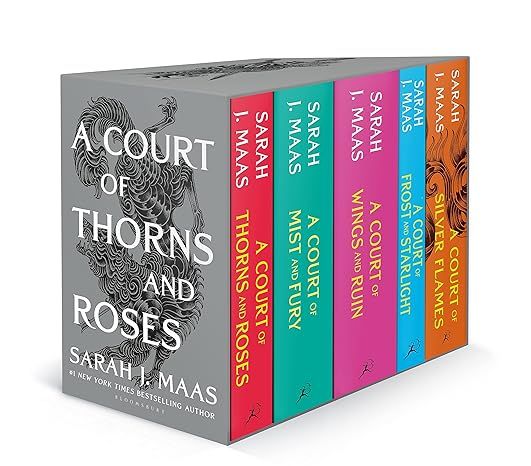
A Court of Thorns and Roses Paperback Box Set (5 books) (A Court of Thorns and Roses, 9)
4.8
-
26,559
$37.99

Pretty Girls: A Novel
4.3
-
88,539
$3.67
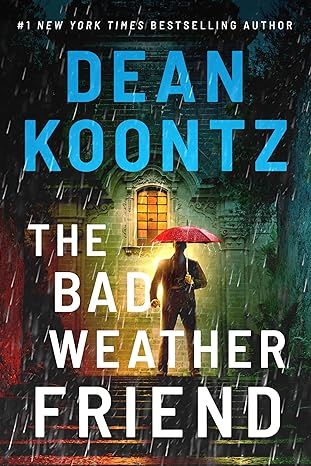
The Bad Weather Friend
4.1
-
34,750
$12.78

Pucking Around: A Why Choose Hockey Romance (Jacksonville Rays Hockey)
4.3
-
41,599
$14.84
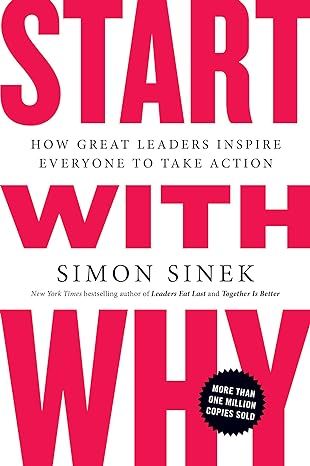
Start with Why: How Great Leaders Inspire Everyone to Take Action
4.6
-
37,152
$9.99
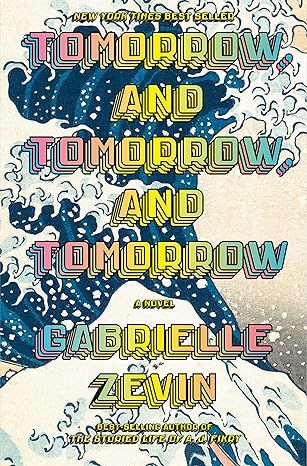
Tomorrow, and Tomorrow, and Tomorrow: A novel
4.4
-
95,875
$13.99

Weyward: A Novel
4.4
-
27,652
$11.99

Tom Lake: A Reese's Book Club Pick
4.3
-
37,302
$15.74
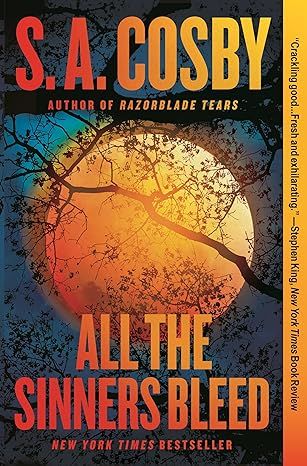
All the Sinners Bleed: A Novel
4.4
-
12,894
$13.55
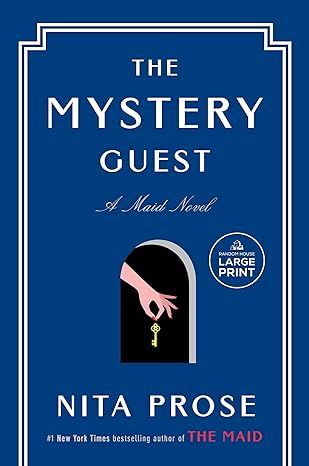
The Mystery Guest: A Maid Novel (Molly the Maid)
4.3
-
9,844
$14.99

Bright Young Women: A Novel
4.2
-
8,485
$14.99
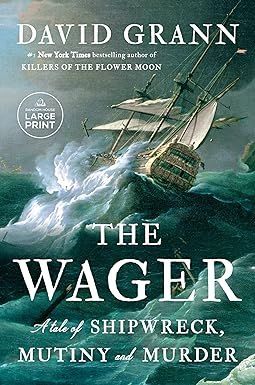
The Wager: A Tale of Shipwreck, Mutiny and Murder (Random House Large Print)
4.5
-
28,672
$14.99
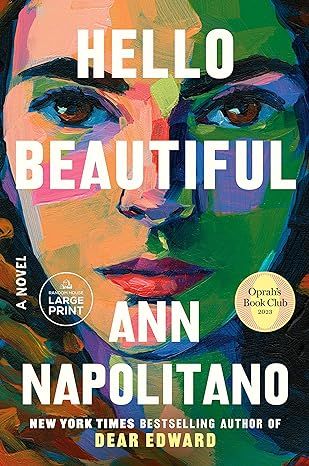
Hello Beautiful (Oprah's Book Club): A Novel (Random House Large Print)
4.4
-
79,390
$14.99
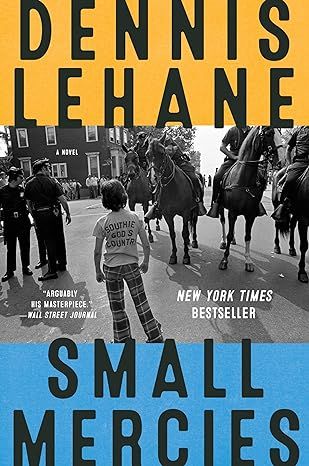
Small Mercies: A Detective Mystery
4.5
-
16,923
$10.00

Holly
4.5
-
31,521
$14.99

The Covenant of Water (Oprah's Book Club)
4.6
-
69,712
$9.24
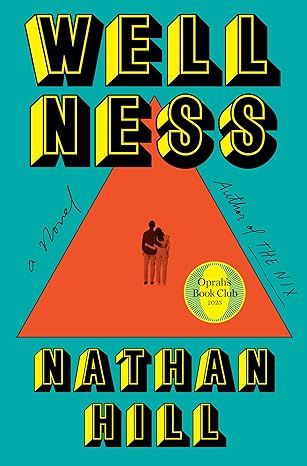
Wellness: A novel
4.1
-
3,708
$14.99
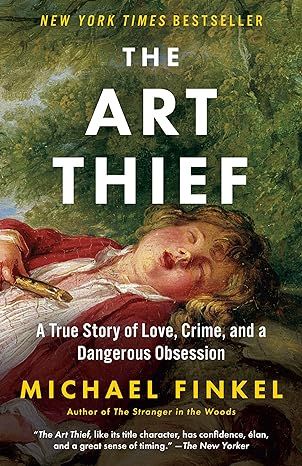
The Art Thief: A True Story of Love, Crime, and a Dangerous Obsession
4.3
-
4,805
$14.99

